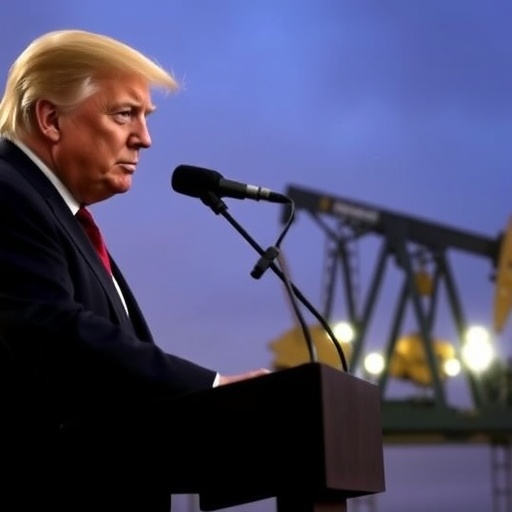Trump Administration Slaps New Sanctions on Russian Oil Giants Amid Escalating Ukraine War Tensions
In a bold escalation of economic warfare, President Donald Trump has imposed fresh Trump sanctions targeting major Russian oil companies, intensifying pressure on Vladimir Putin just weeks after the collapse of high-stakes peace summit plans. The move, announced from the White House Rose Garden on a crisp autumn morning, signals a renewed U.S. commitment to supporting Ukraine’s defense against Russian aggression in the ongoing Ukraine war. As global energy markets brace for turbulence, Ukrainian President Volodymyr Zelensky has called for an even broader assault on Russia’s fossil fuel empire, urging allies to expand the sanctions to the entire Russian oil sector.
The sanctions, which freeze assets and prohibit American firms from engaging with the targeted entities, come at a pivotal moment. With Russian forces reportedly advancing in eastern Ukraine, the U.S. action aims to choke off a critical revenue stream that has funded Moscow’s military operations. Experts estimate that Russian oil exports generate over $100 billion annually, much of which has propped up Putin’s war machine since the invasion began in February 2022. Trump’s decision follows months of diplomatic maneuvering, including the abrupt abandonment of a proposed peace summit in Geneva that was meant to broker a ceasefire but fell apart amid mutual accusations of bad faith.
Sanctions Zero In on Rosneft and Gazprom Neft’s Operations
The Trump sanctions specifically name Rosneft, Russia’s largest oil producer, and Gazprom Neft, a key subsidiary of the state-controlled gas giant Gazprom. These companies, which together account for nearly 40% of Russia’s crude oil output, now face immediate U.S. Treasury Department restrictions. Under the new measures, any U.S. person or entity is barred from conducting business with them, including transactions involving debt, equity, or technology transfers. “This is a direct hit on the arteries of Putin’s economy,” Trump declared during the announcement, flanked by national security advisors. “We’re not just talking words; we’re cutting off the cash that buys tanks and missiles.”
Rosneft, valued at over $80 billion before the latest blow, has long been a symbol of Russia’s energy dominance. Headquartered in Moscow, it operates vast fields in Siberia and the Arctic, exporting millions of barrels daily to markets in Europe, Asia, and beyond. The sanctions build on previous rounds imposed since the Ukraine war erupted, but this iteration includes secondary penalties that could ensnare foreign banks or firms facilitating deals with the sanctioned entities. Gazprom Neft, meanwhile, focuses on refining and upstream production, with assets spanning from the Baltic Sea to the Far East. Industry analysts at BloombergNEF project that these restrictions could slash Russia’s oil revenues by up to 15% in the coming quarter, forcing Putin to seek alternative buyers in sanction-tolerant nations like China and India.
The timing couldn’t be more strategic. Just days before the announcement, satellite imagery from the European Space Agency revealed increased Russian troop movements near Kharkiv, underscoring the urgency of economic leverage. U.S. officials, speaking on condition of anonymity, revealed that intelligence reports linked Rosneft profits directly to funding for Wagner Group mercenaries active in Donbas. “Every barrel of oil sold is a bullet fired at Ukrainian civilians,” one senior diplomat told reporters. This targeted approach reflects a shift in Trump sanctions strategy, moving from broad sectoral bans to precision strikes that minimize global supply disruptions while maximizing pain for Moscow.
Peace Summit Fallout Ignites Renewed U.S. Resolve Against Putin
The abandoned peace summit, initially hailed as a potential breakthrough, has become the catalyst for this aggressive U.S. posture. Scheduled for mid-October in neutral Switzerland, the talks were derailed when Putin refused to attend, citing “unacceptable preconditions” from Kyiv and its Western backers. Russian state media claimed the summit was a ploy to isolate Moscow, while Zelensky accused Putin of using it as a stalling tactic to regroup forces. The failure, which involved envoys from over 30 nations, has left diplomats scrambling and hardened attitudes on both sides.
For the Trump administration, the summit’s collapse was a wake-up call. Sources within the State Department indicate that preparations for the Trump sanctions were accelerated in the aftermath, with interagency meetings convening around the clock. “We came to Geneva in good faith, offering real concessions on territorial integrity,” Zelensky said in a video address from Kyiv’s presidential bunker. “Putin’s rejection proves he has no interest in peace—only in conquest. Now is the time for our allies to hit him where it hurts: his oil wealth.” The Ukrainian leader’s plea resonated in Washington, where congressional leaders from both parties voiced unanimous support for the measures during a rare bipartisan briefing.
Historical context adds weight to the drama. The Ukraine war, now in its third year, has already reshaped global alliances, with NATO expanding and energy flows rerouted. Previous sanctions waves in 2022 froze $300 billion in Russian central bank assets and capped oil prices at $60 per barrel, but evasion tactics like shadow fleets have blunted their impact. This new round incorporates advanced tracking via blockchain and AI to monitor illicit trades, according to a Treasury fact sheet. As one European Union official noted, “The summit was our last olive branch; now it’s sanctions season.” The fallout has also strained U.S.-Russia relations to breaking point, with Kremlin spokesperson Dmitry Peskov labeling the moves “economic terrorism” and vowing retaliatory measures against American interests.
Zelensky Pushes for Total Russian Oil Sector Lockdown
Undeterred by the initial targeting of just two firms, Zelensky has amplified calls for a comprehensive ban on the entire Russian oil industry. In a fiery op-ed published in The New York Times, the Ukrainian president argued that piecemeal Trump sanctions allow Putin to pivot resources and maintain war funding. “Sanctioning Rosneft and Gazprom Neft is a start, but it’s like plugging two leaks in a sinking ship,” Zelensky wrote. “We must seal the hull—every derrick, every pipeline, every tanker carrying Russian oil must be isolated from the world economy.”
Zelensky’s advocacy draws on stark data: Russia’s oil sector, employing over a million people and contributing 30% to its federal budget, remains the linchpin of Putin’s resilience. Despite Western embargoes, Moscow exported 7.5 million barrels per day in September, per OPEC figures, often at discounted rates to bypass caps. Kyiv proposes a coalition-led “oil embargo alliance,” enlisting G7 nations, Australia, and Japan to enforce a total import ban. Ukrainian diplomats are lobbying Brussels for EU alignment, pointing to recent successes in phasing out Russian gas. “If we act now, we can starve the Ukraine war of its fuel,” Zelensky urged during a virtual NATO summit.
Support for expansion is growing. UK Prime Minister Rishi Sunak echoed the sentiment, stating, “Zelensky is right—half-measures embolden Putin.” In the U.S., Senate Foreign Relations Committee Chair Bob Menendez introduced legislation to broaden the Trump sanctions, potentially adding 20 more Russian oil entities. However, challenges loom: A full sector ban risks spiking global prices to $120 per barrel, per IMF models, hitting inflation-weary consumers. Environmental groups like Greenpeace hail the move as a dual win for peace and climate, arguing it accelerates the shift from fossil fuels. As Zelensky tours European capitals, his message is clear: Expand or endure.
Global Energy Markets Reel from Sanctions Shockwave
The Trump sanctions have sent ripples through international energy markets, with Brent crude futures jumping 5% to $92 per barrel in after-hours trading. Traders fear supply squeezes as Russian oil seeks new outlets, potentially straining OPEC+ dynamics. In Europe, where Russia once supplied 40% of oil imports, leaders are accelerating diversification; Germany announced $10 billion in LNG terminal investments, while France eyes African suppliers. “This is the volatility we’ve dreaded,” said Fatih Birol, executive director of the International Energy Agency, in a statement. “But it’s necessary to deter aggression in the Ukraine war.”
Economic fallout extends beyond prices. Russian oligarchs tied to Rosneft, like Igor Sechin, face personal asset freezes in the U.S. and allies, compounding losses from earlier seizures of yachts and villas. In Moscow, the ruble dipped 3% against the dollar, and stock indices tumbled as investors fled energy stocks. Putin’s response included threats to cut gas flows to Europe, though winter stockpiles mitigate immediate risks. Asian markets, particularly India, which buys 1.5 million barrels daily from Russia, watch warily; New Delhi has urged restraint to avoid fueling its own inflation.
U.S. domestic impacts are mixed. While American shale producers stand to gain from higher prices—boosting output in Texas and North Dakota—consumers brace for pump prices averaging $4.50 per gallon. The Biden-era Inflation Reduction Act’s clean energy incentives now seem prescient, with EV sales surging 20% year-over-year. Analysts at Goldman Sachs forecast that sustained Trump sanctions could redirect $50 billion in Russian oil revenues toward renewables globally, hastening the energy transition. Yet, for now, the markets embody uncertainty: A barometer of geopolitical strife in the Ukraine war.
Allies Gear Up for Coordinated Push as Putin Vows Defiance
International solidarity is coalescing around the Trump sanctions, with NATO allies pledging synchronized actions. Canada and Australia announced parallel measures against Russian oil facilitators, while Japan committed to reducing imports by 30%. In a joint communique, G7 finance ministers affirmed, “We stand with Ukraine against Putin’s imperialism.” Zelensky, in a phone call with Trump, thanked the U.S. but pressed for more: “Your sanctions save lives; let’s make them unbreakable.”
Putin, addressing the Federal Assembly, dismissed the moves as “desperate flailing” and hinted at asymmetric retaliation, including cyber operations or alliances with Iran and North Korea. Russian Foreign Minister Sergey Lavrov warned of “irreversible consequences” for global trade. Despite the bravado, internal pressures mount: Protests in oil-rich regions like Tatarstan signal discontent over economic woes tied to the Ukraine war.
Looking ahead, the sanctions’ efficacy hinges on enforcement and unity. U.S. officials eye AI-driven monitoring to curb shadow shipping, while diplomatic channels remain open for de-escalation. If expanded as Zelensky urges, a full Russian oil blockade could force Putin to the table—or deepen the quagmire. As winter looms over Ukraine’s frontlines, these economic weapons may prove decisive in tipping the scales toward peace or prolonging the fight.










